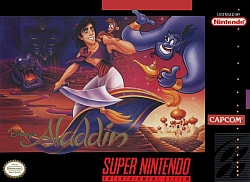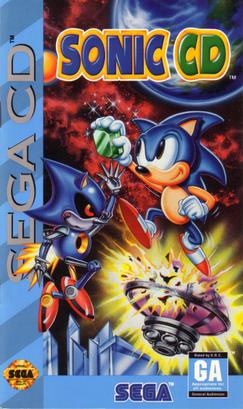|
Disney's animation studios were completely crushing it in the 90's. Movies like Aladdin, The Lion King and Beauty and the Beast were inescapable. And on the TV front they had stuff like Darkwing Duck, Ducktales and Chip N Dale: Rescue Rangers. These were properties aimed at kids, sure. But they were also kinda cool. Cool enough that even teenagers and (possibly stoner?) twenty-somethings were paying attention. And none of that was lost on game publishers who rushed out to license these names and pump out games.
Back in 1993 the console wars were in full swing, but I was playing both sides. I had pretty much settled on my SNES as the winner, but was still picking up plenty of quality Genesis games as well. When Aladdin was released for the 16-bit consoles, I don't remember if I bought it or if I borrowed it from a friend, but it was definitely the Genesis version. At the time, I pretty clearly remember the Genesis version being hyped up for having better animations and more authentic renditions of the movie music. I don't even really remember much about my initial impressions of the game. I guess I liked it, but it didn't really stick with me. But many years later, I did revisit the Genesis version and while I was still impressed by the visuals and audio, I didn't think it was a great game. It seemed way too hard. The controls felt clunky with floaty jumping and weird hit detection. Also, the levels seemed really badly designed. You had to collect certain items to finish a level, and the foreground and background was sometimes hard to distinguish, making the maze-like structure even more of a burden. I'll be honest, though. I don't think I even realized that the SNES and Genesis versions of Aladdin were two completely different games until the 2021 re-release on Xbox One. So here's the quick rundown: GENESIS - This version was made by Virgin Games, best known for their Earthworm Jim series. This completely explains the floating jumping, clunky controls, lack of visual clarity in level design, and awful maze level layouts. SNES - This version was made by Capcom, known for making a plethora of quality Disney games on NES like Ducktales, Darkwing Duck, Chip N Dale. Oh, and Shinji Mikami worked on this one... who later went on to create Resident Evil and The Evil Within. Now which of the above games sound more enticing to you? Knowing the history now, I can't help but I played the wrong game in 1993. But I'm righting that wrong now. Thanks to that Xbox One collection, we've now got a bunch of versions of Aladdin (and Lion King and The Jungle Book) to dig through. Having now played through the SNES version of Aladdin on my Xbox Series X (what a weird sentence), I have to say that this was really the better of the two. The graphics have that classic Capcom licensed look that we loved from those old NES games, but scaled up to 16-bit. The color pallet is muted yet tasteful. The controls are tight, with a strong emphasis on platforming and swinging from various spots in the environment. It's a challenging game, but never feels cheap. The same cannot be said for the Genesis version. Overall, it's a pretty short game as well. I had no trouble getting through it in just a few hours, but that made it a nice little retro pallet cleanser between bigger games. There's only a handful of bosses, but they're done well. Again, if you loved bosses in say Ducktales, then this will feel good and familiar to you. The final boss against the snake form of Jafar is especially neat. So yeah, my verdict is this - the Virgin Genesis game is one that survives memory due to rose tinted glasses. But it actually kind of sucks. The SNES version by Capcom is pretty much an overlooked and forgotten gem. It's by no means a must-play. But it is way better than you probably realize.
0 Comments
The Sega CD is not remembered fondly in gaming history. But it holds a special place in my heart. You can scoff at its over reliance on FMV games now, and that's fine. But when it came out it was a pretty huge deal to me. And if I'm being honest, getting my Sega CD for Christmas in 1992 was probably the coolest thing Santa ever brought me as a kid. It just seemed to futuristic.
It's fair to say that the library came out in a slow drip, however. But about a year after launch, we got Sonic CD in America. And this game really blew my mind. Keep in mind, this was the first console sequel after Sonic 2, but it was on hardware that not a lot of gamers had. So it seems that Sonic 3 (meh) is often remembered more fondly. But for me, Sonic CD was a really big deal. The early 90's are full of Sega nostalgia for me. Christmas 1991 was all about the Genesis for me, and its pack-in at the time, Sonic The Hedgehog. For my birthday in 1992, I received a Game Gear. And then for Christmas that year, it was the Sega CD. I was a huge Sega kid. And I think that the first of half of the 90's is so full of important games and all of them are tied to this nostalgia for me of a time when I was still a kid. I think back to these birthdays and Christmas mornings where my only responsibilities were to wake up, open gifts, and play video games all day. Anyway, Sonic CD. Now that's a good game. It was released between Sonic 2 and 3, but wasn't a numbered sequel. My guess is that because the install base of the Sega CD was so low, they didn't want to put a "real" sequel on there. But maybe they should have called it Sonic 3 to sell some more units? Maybe that would have opened people's eyes to the 2D powerhouse that the Sega CD could be. Everyone remembers it for low budget FMV games. Really though, there were games like Sonic CD and Lunar and Vay that most gamers were missing out on because they wouldn't embrace the hardware. Right off the bat, Sonic CD opens with an amazing anime intro. I've always loved this video. Even the Americanized music. And then we get into the game proper, which ditches Tails but introduces Amy Rose and Mecha Sonic. The gameplay itself is classic 2D Sonic, owing way more to the original game's linearity than even Sonic 2. And if you're like me, and kind of dislike the more labyrinthian levels of Sonic 3, then you should appreciate this one a lot. The big difference here is the past/present/future mechanic. Each level takes place in the present by default, but you can actually travel to the past or future and play a slightly different version of the level. It's inventive, certainly. And yet, has never really been revisited in the series. Supposedly, this game takes place between Sonic 1 and 2 as far the story goes. At least according to the new Sonic Origins compilation on Xbox Series X. But who knows? I've never played Sonic games for their story. Every early Sonic game had completely new bonus stages, and this one is no different. Thanks to the horsepower of the Sega CD, Sonic Team decided to show off the Mode7-like capabilities of the system, so we basically get Sonic running around on Mario Kart looking courses. It sounds better than it plays. So what's it like replaying an underdog game in an insanely popular series that I've been championing for thirty years now? Well, it's still super solid in my opinion. Honestly, the Sonic Origins series feels mostly unnecessary. Sonic 1 and 2 have been re-released a million times. Admittedly, Sonic 3 & Knuckles has been a little less easy to get your hands on as of late. But Sonic CD is the real gem for me here. I mean, I've had the Sega Genesis Classics collection since it was released back in 2017. Sonic Origins is definitely barebones in the big picture. There's "classic" versions of each game, which are basically just ROMs for the most part (music licensing aside). But there's also new versions of each, which put them in widescreen and remove lives, making continues moot. Beyond that... there's no other quality of life improvements seen in most retro collections these days. No rewind feature. No save states (though there is an auto-save between levels). There's some music and video museum stuff, but this is miles away from a Digital Eclipse compilation as far as features go. But here's the thing – Sonic CD is an important enough game to me that I needed to have Sonic Origins. It's wrapped up in nostalgia, sure. But it's also a fantastic 2D Sonic game, and one that I think is vastly underrated. |
Games
All
Archives
February 2024
|


 RSS Feed
RSS Feed
